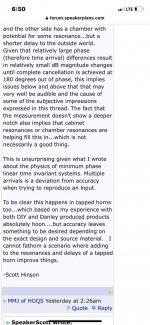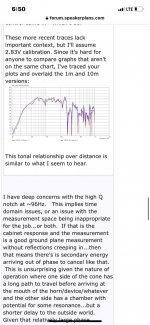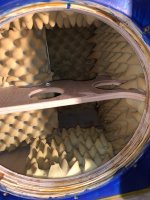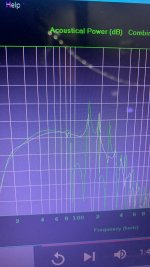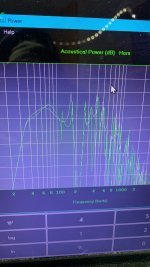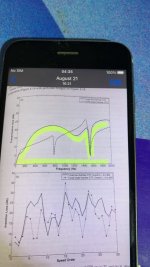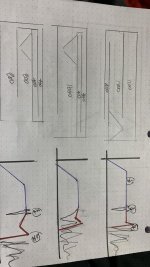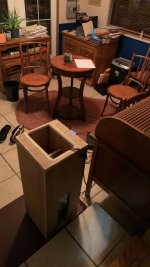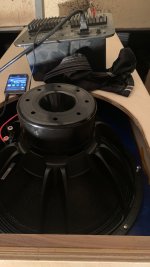Anyone deal with this issue in parallel qw pipes seperated by an odd harmonic interval (3/1) or audibly annoyed/aware of or by it in offset driver entry transmission lines aimed at the three times one quarter harmonic resonance? (Very similar ?)
or maybe in randomly spaced parallel Bp 6/8 alignments ?
or maybe in randomly spaced parallel Bp 6/8 alignments ?
Attachments
Last edited:
Hmm, if I understand you/the problem, not the same, i.e. this was/is my long term 'gripe' WRT the BWC's performance, but my total animosity towards all things B@$3 blinded me to the obvious, which is to complete the acoustic 'chain', i.e. the late, great DJK's 1/2 square wave antenna 'cure' by folding it at the right points.
edit: If true, then the more pipes, the more 'loops in the chain' to 'close', making for a bit of a folding 'nightmare' and why I haven't bothered to waste any time 'bench racing' these otherwise interesting 'calliopes from Hell'. 😉
Just realized that I'd done such a good job of not thinking about them to almost forget that my interest in TL design theory was to understand, design advanced intake, exhaust systems, so 'been there done that' for the most part learning how to design the 'bundle of snakes' exhaust systems pioneered by Cosworth?/Ford for the Lotus Ford Indy cars and quickly added to Ford's new GT40 international sports racer, so look to those for folding insight.
edit: If true, then the more pipes, the more 'loops in the chain' to 'close', making for a bit of a folding 'nightmare' and why I haven't bothered to waste any time 'bench racing' these otherwise interesting 'calliopes from Hell'. 😉
Just realized that I'd done such a good job of not thinking about them to almost forget that my interest in TL design theory was to understand, design advanced intake, exhaust systems, so 'been there done that' for the most part learning how to design the 'bundle of snakes' exhaust systems pioneered by Cosworth?/Ford for the Lotus Ford Indy cars and quickly added to Ford's new GT40 international sports racer, so look to those for folding insight.
Last edited:
What if these are tied together a@ exit instead ? Seems the 3:1 is ‘perfect’ in HR, but so is adding a certain point of csa increase or decrease (pipe, NOT taper/flare).Hmm, if I understand you/the problem, not the same, i.e. this was/is my long term 'gripe' WRT the BWC's performance, but my total animosity towards all things B@$3 blinded me to the obvious, which is to complete the acoustic 'chain', i.e. the late, great DJK's 1/2 square wave antenna 'cure' by folding it at the right points.
edit: If true, then the more pipes, the more 'loops in the chain' to 'close', making for a bit of a folding 'nightmare' and why I haven't bothered to waste any time 'bench racing' these otherwise interesting 'calliopes from Hell'. 😉
Just realized that I'd done such a good job of not thinking about them to almost forget that my interest in TL design theory was to understand, design advanced intake, exhaust systems, so 'been there done that' for the most part learning how to design the 'bundle of snakes' exhaust systems pioneered by Cosworth?/Ford for the Lotus Ford Indy cars and quickly added to Ford's new GT40 international sports racer, so look to those for folding insight.
it has obvious ways that you can incorporate driver offset position that won’t screw anything up either if it is matched on both sides from each closed end as well.
I guess the offset driver mode preferring the pi divided by nine number(0.3490658… or 20 degrees as radians) would as driver entry works because of things like end correction on the propogating wave Toward exit (?)but it’s interesting how 3 meters(28.8 hz @ 345.6 m/sec) has a node at 3.1416 essentially just outside the pipe. And then harmonics @ 86.4,144,201.6, 259.2…. 3,5,7,9…
I can’t tell if Scott Hinson is just attacking that particular design, because ‘Paraflex ‘ never actually lines these up just ‘right’ , and always has this issue or (worse in a boundary condition) that he’s just referring to all qw pipes that try to take advantage of the next harmonic as well, which would essentially say that he says all offset entry full range transmission line speakers inherently ‘suck’ and are screwed up for the same reason too??
Don’t understand his argument, unless he’s talking about things that are wrong because someone has tried to do too much and not aligned those as both sides of the driver to the actual harmonic and horn response simulation tools you see this scar that exists in the overlap as well as is represented in group delay, and everything else. As a result of the great detail we get to see it horn response that allows us to understand so much more, and with such a precision above, and beyond what we can even build with braced Wood for that matter.
Last edited:
A ‘parallel -series pipe’ at 3:1 , or not and that ‘scar’
Attachments
Last edited:
This has no scar as depicted in this book, but retains the same shape in the frequency response that horn response shows where there is that signature curve in the perfect 3:1 parallel pipes after the third harmonic, that isn’t flat, but is not misaligned pressure of phase. It would be interesting to interpret why these shapes exist at that location instead of otherwise.??
Attachments
These don’t seem to work very good because there is a substantial space between both exit and so the system is not loading against itself, and the idea of the front and rear outputs incorporated in the same exact dimensions as that three to one relationship doesn’t have the 3:1 Harmonicspacing is now fouled By some 30-40cm? If that was happening inside the box, it would be a very huge detriment to that area of the band with which is ultimately the same thing as the scar shape. I keep trying to represent.??This has no scar as depicted in this book, but retains the same shape in the frequency response that horn response shows where there is that signature curve in the parallel pipes after the third harmonic, that isn’t flat, but is not misaligned pressure of phase. It would be interesting to interpret why these shapes exist at that location instead of otherwise.??
Attachments
Not really following all the above to this point beyond Scott's no dummy, he ran (and owned?) the Basslist in college and been involved with TL/TH from at least the beginning of the Tom Danley era, though like you not sure what his 'beef' is other than maybe the same reason as my not being enthused with the paraflex, which is the same as my long standing not being enthused with the original Karlson (4) box BP.These don’t seem to work very good because there is a substantial space between both exit and so the system is not loading against itself, and the idea of the front and rear outputs incorporated in the same exact dimensions as that three to one relationship doesn’t have the 3:1 Harmonicspacing is now fouled By some 30-40cm? If that was happening inside the box, it would be a very huge detriment to that area of the band with which is ultimately the same thing as the scar shape. I keep trying to represent.??
Yes, it does approximate a bass horn (as defined in the mid '50s, nowadays mid-bass) in a very compact space regardless of its techno-babble marketing concept dooming it till recently, ditto these newer ever higher order BPs with the consequence of ever greater 'ringing' that is fine for (long distance) prosound apps due to HF sound absorption over distance/DSP, but shrinks usable nearfield BWs down to as little as 'half note' 'boom boxes' that without modern DSP wouldn't be viable for anyone not already tone deaf, which among the youth with 'boom box' vehicles in my locale combined with the current popular (sub) bass under/overtones saturated 'music' means basically all of them as they're getting pounded by it from birth.
Oh well, my parents raised on unamplified music 'preached' similar to my R&R and my generation re my kid's outrageously loud concerts (comparing to my standing right next to top fuel dragsters being tuned up without hearing protection to my perceived loudest concert, Deep Purple at the local Fox Theatre Palace), dance halls, so the old adage 'what goes around, comes around and where it stops, nobody knows' is still alive n' well!

Yeah.. I can’t tell if Scott is being overly critical to write another paper or if this is really a legit concern in OD TL @ ~1/3 ?
hes very aggressive in FB groups about all of this so it’s strange when you don’t ‘hear’ or measure anything as much as paraflex shows in that approach to parallel/series exit qw pipes .
seems they are simply not lining up both sides appropriately, and that whole issue then is worth mentioning because I have experienced that and Scott makes sense.. but I don’t understand how that pertains to the ODTL if at all(maybe those are just easier to built ‘perfectly aligned’ and paraflex is whatever mess it is on its own. There’s no odd harmonic used in them accurately. Messy overlap can be seen in any of them. It’s off by a decent margin. Some type C path lengths come close it seems out of all of them.
they Ring like crazy or go dead on freqs in that area of overlapping discontinuity. Fun to play with/tweak into flat/smooth and ‘different/much better’ if built as ‘3:1‘ precisely
hes very aggressive in FB groups about all of this so it’s strange when you don’t ‘hear’ or measure anything as much as paraflex shows in that approach to parallel/series exit qw pipes .
seems they are simply not lining up both sides appropriately, and that whole issue then is worth mentioning because I have experienced that and Scott makes sense.. but I don’t understand how that pertains to the ODTL if at all(maybe those are just easier to built ‘perfectly aligned’ and paraflex is whatever mess it is on its own. There’s no odd harmonic used in them accurately. Messy overlap can be seen in any of them. It’s off by a decent margin. Some type C path lengths come close it seems out of all of them.
they Ring like crazy or go dead on freqs in that area of overlapping discontinuity. Fun to play with/tweak into flat/smooth and ‘different/much better’ if built as ‘3:1‘ precisely
Last edited:
Well, I assumed he wasn't 'lumping in' the MLTL per se, though folded up, one can certainly screw up its otherwise stellar performance same as the higher order ones if not winding up with the vent next to, and on the same baffle as the driver, so guess he could be..........YMMV, etc..
I think that’s been and continues to be overlooked.🥲
Folding is ‘dilution / pollution’. or it’s on point with the sine wave at Pmax/v max intervals (3 x 1/4 wave harmonic parts are obvious at 0.00/~0.349/~0.651/1.00 (just outside the exit impedance, so to speak ) and has no detrimental affects
if this were 3 meters, then:
1.0472
2.0944
3.1416(just outside the 3.000metet qw pipe?)
60 degrees
120 degres
180 degrees (pi) ironically, if not ‘radians’
then its:
28.8 hz(fundametal)
86.4 hz(notch filled in)
144 hz (end of BW notch/cancel) if vent/driver concentric
300cm
100cm
60 cm
Folding is ‘dilution / pollution’. or it’s on point with the sine wave at Pmax/v max intervals (3 x 1/4 wave harmonic parts are obvious at 0.00/~0.349/~0.651/1.00 (just outside the exit impedance, so to speak ) and has no detrimental affects
if this were 3 meters, then:
1.0472
2.0944
3.1416(just outside the 3.000metet qw pipe?)
60 degrees
120 degres
180 degrees (pi) ironically, if not ‘radians’
then its:
28.8 hz(fundametal)
86.4 hz(notch filled in)
144 hz (end of BW notch/cancel) if vent/driver concentric
300cm
100cm
60 cm
Last edited:
oh thanks, like we needed another can of worms😝😝😝Depends on the pipe end correction to accurately determine them all.
Attachments
- Home
- Loudspeakers
- Subwoofers
- Multiple resonators causing multiple issues in the response ?
